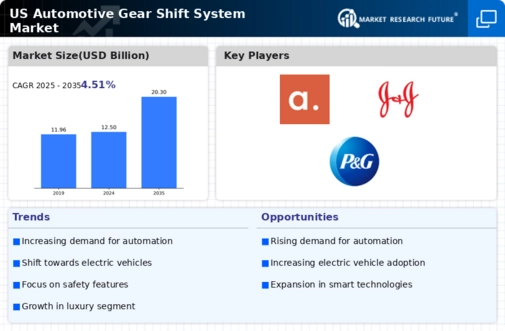Growth of the Automotive Industry
is benefiting from the overall growth of the automotive industry in the US. As vehicle production ramps up, driven by increasing consumer demand and economic recovery, the need for efficient and reliable gear-shift systems becomes paramount. In 2025, the automotive industry is projected to generate revenues exceeding $800 billion, with a significant portion allocated to the development and integration of advanced gear-shift technologies. This growth is likely to stimulate investments in research and development, further propelling innovations in the automotive gear-shift-system market. As manufacturers strive to meet consumer expectations for performance and reliability, the market is poised for substantial expansion.
Rising Demand for Fuel Efficiency
is witnessing a surge in demand driven by consumers' increasing focus on fuel efficiency. As fuel prices remain volatile, consumers are more inclined to choose vehicles that offer better mileage and lower operational costs. This trend is prompting manufacturers to invest in advanced gear-shift technologies that optimize engine performance and enhance fuel economy. In 2025, it is estimated that vehicles featuring innovative gear-shift systems will achieve fuel efficiency improvements of up to 20%, making them more appealing to cost-conscious consumers. Consequently, the automotive gear-shift-system market is likely to expand as manufacturers respond to this growing demand for fuel-efficient vehicles.
Regulatory Push for Emission Reductions
The automotive gear-shift-system market is significantly influenced by stringent regulatory frameworks aimed at reducing vehicle emissions. In the US, regulations set by the Environmental Protection Agency (EPA) mandate lower emissions for new vehicles, compelling manufacturers to innovate and adopt more efficient gear-shift systems. This regulatory push is expected to drive the market towards the adoption of technologies that enhance fuel efficiency, such as automated manual transmissions (AMT) and hybrid systems. By 2025, it is anticipated that vehicles equipped with advanced gear-shift systems will account for over 40% of new car sales, reflecting a shift towards compliance with environmental standards and consumer demand for greener alternatives.
Consumer Shift Towards Smart Technologies
is increasingly influenced by the consumer shift towards smart technologies in vehicles. As infotainment systems and connectivity features become standard, there is a growing expectation for gear-shift systems to integrate seamlessly with these technologies. This trend is prompting manufacturers to develop gear-shift systems that not only enhance driving experience but also offer connectivity features, such as remote control and adaptive shifting. By 2025, it is anticipated that smart gear-shift systems will represent a significant segment of the market, appealing to tech-savvy consumers. This integration of smart technologies is likely to drive innovation and competition within the automotive gear-shift-system market.
Technological Advancements in Transmission Systems
The automotive gear-shift-system market is experiencing a notable transformation due to rapid technological advancements in transmission systems. Innovations such as dual-clutch transmissions (DCT) and continuously variable transmissions (CVT) are gaining traction, enhancing vehicle performance and fuel efficiency. In 2025, the market for advanced transmission systems is projected to reach approximately $15 billion, reflecting a robust growth trajectory. These advancements not only improve driving dynamics but also align with consumer expectations for smoother gear transitions and enhanced driving experiences. As manufacturers increasingly adopt these technologies, the automotive gear-shift-system market is likely to witness a surge in demand, driven by the need for improved vehicle performance and efficiency.

















Leave a Comment